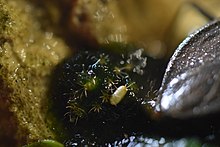Water scorpion
| Water scorpion | ||||||||||||
|---|---|---|---|---|---|---|---|---|---|---|---|---|

Water scorpion ( Nepa cinerea ) |
||||||||||||
| Systematics | ||||||||||||
|
||||||||||||
| Scientific name | ||||||||||||
| Nepa cinerea | ||||||||||||
| Linnaeus , 1758 |
The water scorpion ( Nepa cinerea , syn .: Nepa rubra ) is an insect from the family of scorpion bugs (Nepidae) in the sub-order of water bugs (Nepomorpha). It occurs scattered in large parts of Europe , in Africa and in northern Asia (excluding China ). In addition, there are only a few other species in the genus Nepa , including the blind, cave-dwelling Nepa anophthalma and the American species Nepa apapiculata . In Central Europe , the water scorpion is the only representative of its genus.
features
Water scorpions reach a body length of 17 to 25 millimeters, plus an approximately 10 millimeter long breathing tube, the width is between 6 and 10 millimeters. The color is dark to gray-brown, sometimes also reddish. They have strong, flat bodies and a long, two-part breathing tube at the end of the abdomen. Despite fully developed wings , their ability to fly is sometimes questioned - in contrast to the closely related stick bug ( Ranatra linearis ). The head is small, triangular and equipped with two hemispherical eyes and a short proboscis . The pair of forelegs has been transformed into catch legs - the bug also owes its common name to these and the breathing tube. The middle and rear legs are used for locomotion, but due to the lack of swimming bristles, locomotion in open water is awkward. An air bubble under the wings allows the animal to swim on the surface of deeper water without sinking. Water scorpions have a relevant, almost monostrophic right-left characteristic: in around 97% of individuals, the membrane of the right hemielytre lies above the left. So it can be seen here in the film document of the preparations of an individual to sunbathe and take off.
Way of life
Shallow water zones close to the banks of standing or slow-flowing, muddy waters form the preferred habitat. The range of prey includes water fleas , aquatic insect larvae , young small fish and larvae ( tadpoles ) of amphibians .
Water scorpions sit on aquatic plants , in the mud or on old leaves, where they lurk for food . If a prey approaches its predatory legs, its foot quickly folds towards the lower leg and the victim is trapped. The animals stab the prey with their proboscis and then suck it out. The breathing tube is always kept within reach of the water surface, it rarely happens that water scorpions are in deeper areas of water or on land. When they are not sitting or resting, they usually walk along stalking the flat ground.
development
After mating in spring, the female lays 10–20 eggs in rotten plant parts or algae floss. The eggs have several (usually seven) threads of breath that are in contact with the water surface and are used to supply oxygen. The larvae hatching from the eggs between May and July go through five stages of development, separated by moults, until they reach the adult stage around September. The overwintering takes place as an imago on the bottom of muddy waters. The species can reach an age of several years.
Web links
- Nepa at Fauna Europaea
literature
- Wolfgang Engelhardt : What lives in pools, brooks and ponds? Kosmos-Franckh, Stuttgart 1986 (12th edition), ISBN 3-440-05444-6 .
- Karl Hermann Jordan : Water bugs . The New Brehm Library, Leipzig 1950.
- Ekkehard Wachmann : bugs, watch, get to know. Neumann-Neudamm, Melsungen 1989, ISBN 3-7888-0554-4 .
- E. Wachmann, A. Melber & J. Deckert (2006), Bugs 1 - Tierw. Deutschlds., 77, pp. 17-19, ISBN 3-931374-49-1
Individual evidence
- ↑ Integrated Taxonomic Information System: Entry on Nepa cinerea ( page no longer available , search in web archives ) Info: The link was automatically marked as defective. Please check the link according to the instructions and then remove this notice.






